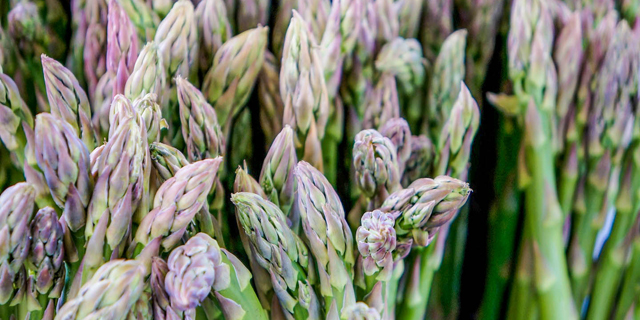Asparagus is a bright and hearty green that packs over 250 milligrams of potassium, 3 grams of fiber, and clocks in at only 40 calories per cup. Rich in Vitamin K and Vitamin A, asaparagus is crucial for strengthening your bones and boosting your vision. Best of all, asparagus is delicious, and, coupled with its list of health benefits, you can enjoy as much of it as you want, guilt free! Here, everything you need to know abou this green power giant.
Related: Fresh Spring Dishes: Shaved Asparagus Salad [Video]
How do I pick the best asparagus?
You can find asparagus in an array of colors: from green to purple to white. Look for firm, thick stalks with tightly closed dark green or purple tinged tips. On the other end, steer clear of woody, shriveled and dry ends as well as flowers, which indicate that the stalks are past their prime. As with any produce, a bright color means the asparagus is fresh and ripe for the picking. Don’t be shy! Choose the most colorful asparagus you can find.
If you plan to harvest your own asparagus from a local farm or coop the same rules apply. Look for brightly colored, firm stalks. Buds should be tight with a deep green/purple color. Spears that have grown 8 inches past the soil line can be snapped or cut off at the soil line. If you want to plant them yourself, you’re in luck: although harvest doesn’t begin until the plant’s third season, asparagus is perennial which means it will return for your eating pleasure every spring, year after year…after year.
[ pagebreak ]What can I make with asparagus?
A versatile vegetable, asparagus can be grilled, steamed, pickled, roasted, sautéd, fried, baked, or eaten raw. From a simple sauté with olive oil and fresh garlic to roasted asparagus soup or a crisp asparagus slaw, the possibilities are endless.
No matter what cooking method you favor or choose, to maintain its bright color, crisp texture and delicate flavor do not overcook. Cooked spears should be bright green, warmed through, and should remain erect and firm.
Preparation most often involves the “snap” method, which involves bending the stalk until it naturally snaps and discarding the ends. However, this method can lead to a loss of perfectly tender bits. Instead, trim the ends and peel off the woody outer skin found on the end of the asparagus.
Storage? Asparagus will keep fresh and bright in the refrigerator for 2-3 days. To freeze, blanch spears, cool completely, dry and pack in a tightly sealed ziplock bag. Frozen blanched asparagus will last up to twelve months, so stock up while the pickings are fresh and enjoy them throughout the year until next harvest.
Want to try your hand at some asparagus recipes? No problem; we’ve got you covered. Try our Serrano Wrapped Asparagus, Garlic Asparagus with Chorizo, or for a beautiful spring soup, our Sopa Verde Picante.


![Making Mealtime Matter with La Familia: Easy Sofrito [Video]](https://thelatinkitchen.com/wp-content/uploads/2015/10/sofrito-shutterstock__0-500x383.jpg)
![Easy Latin Smoothies: Goji Berry Smoothie [Video]](https://thelatinkitchen.com/wp-content/uploads/2015/12/goji_berry-shutterstock_-500x383.jpg)
















![Fun and Fast Recipes: Fiesta Cabbage Salad [Video]](https://thelatinkitchen.com/wp-content/uploads/2015/11/fiesta_cabbage_slaw-shutterstock_-500x383.jpg)









